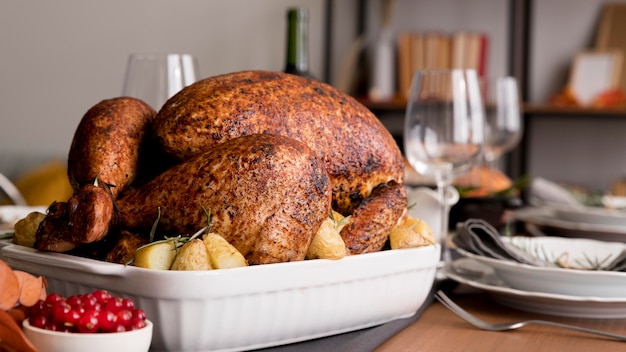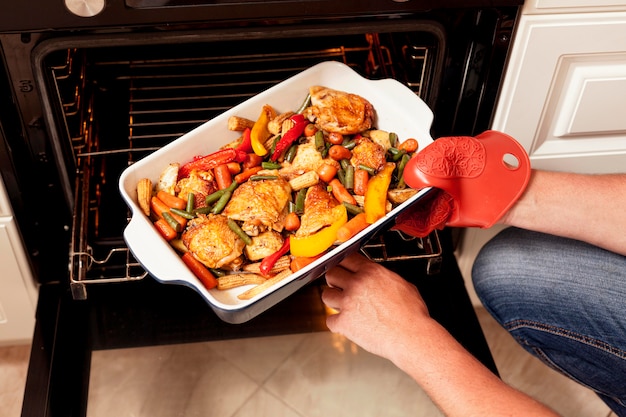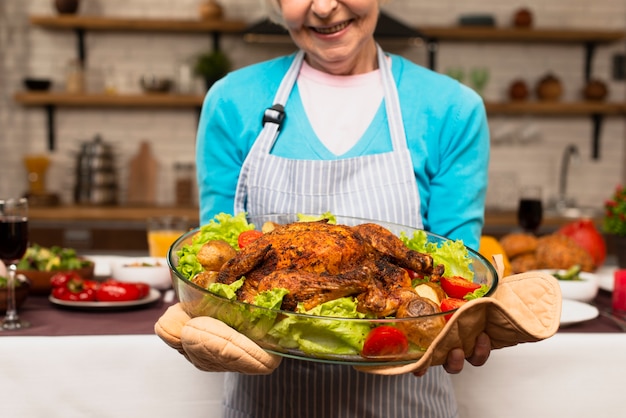There's something undeniably satisfying about a perfectly roasted chicken. The crispy skin, the juicy meat, the intoxicating aroma that fills your kitchen - it's a culinary triumph that makes you feel like a true master chef. But let's be honest, the thought of roasting a whole chicken can be a little intimidating, especially if you're not sure how long to cook it.
Fear not, fellow home cooks! I'm here to guide you through the process, from choosing the right bird to achieving that gloriously golden-brown skin. Think of this as your ultimate guide to roasting a whole chicken, filled with tips, tricks, and a sprinkle of personal experience to make the journey even more delicious. So grab a glass of something refreshing, and let's get cooking!
Part 1: Choosing the Right Chicken

It all starts with the right chicken. You know that feeling when you pick up a piece of meat and it just feels right? That's what we're going for here! I'm a firm believer in supporting local farmers and opting for free-range chickens whenever possible. They just have a richer flavour and a better texture, in my opinion. But if you're limited to supermarket options, don't despair - a good quality store-bought chicken will do the trick.
Size Matters
The size of your chicken is key. A petite 1.5kg bird will cook much faster than a hefty 2.5kg behemoth. So, before you get carried away with visions of a giant roasted chicken, check the weight on the packaging. It's always better to err on the side of caution and go for a slightly smaller bird, especially if you're a beginner. You can always add a few extra veggies to the roasting tray if you need to bulk things up.
Freshness is Key
You want a chicken that's fresh and vibrant, not one that's seen better days. Here's what to look for:
- Colour: A healthy chicken will have pale yellow or cream-coloured skin. Avoid anything that looks overly pale or has a greyish hue.
- Texture: The flesh should feel firm and springy to the touch. Avoid any chicken that feels soft or mushy.
- Smell: The chicken should have a mild, pleasant aroma. If it smells sour or like ammonia, it's a sign that it's not fresh.
If you're unsure about a chicken's freshness, don't hesitate to ask the butcher for advice. They're the experts, after all!
Part 2: Prepping for Perfection

Once you've got your chicken home, it's time to give it a little pampering to prepare it for its starring role in the oven. This is where we turn a basic bird into something truly special.
Patting it Dry
The first step is to pat the chicken dry with kitchen paper. This might sound like a simple step, but it's crucial. A dry chicken will develop a lovely crispy skin, while a wet one will steam instead of roast.
Seasoning with Savour
Now for the fun part - seasoning! I'm a firm believer in the power of simple seasoning. A generous sprinkle of salt and pepper, along with a little bit of freshly ground garlic powder, is all you really need. However, you can certainly get creative here. Rosemary, thyme, and sage all pair beautifully with chicken. And if you like things a bit spicier, a pinch of cayenne pepper or smoked paprika will add a kick.
Rub the seasoning all over the chicken, making sure to get under the skin as well. This will infuse the meat with flavor and create a more succulent result.
Stuffing with Flair
Stuffing a chicken is optional, but it can add a delicious dimension of flavour. I love to stuff mine with a mixture of herbs, lemon slices, and onions. The key here is not to pack the stuffing too tightly. You want the stuffing to cook evenly, and for that, it needs a little space to breathe.
Part 3: Roasting to Golden Perfection

Now for the main event! It's time to send your chicken to the oven to transform into a culinary masterpiece.
Oven Temperature: Finding the Sweet Spot
Most recipes recommend roasting chicken at 180°C (350°F) or 190°C (375°F). I tend to go with 180°C (350°F), as I've found it creates a lovely golden-brown colour without drying out the meat. However, if you want a crispier skin, you can go for the higher temperature. The key is to find the sweet spot that works best for you and your oven.
roasting time: A Guide to Timing
The roasting time will depend on the size of your chicken. As a general rule, you'll need about 20 minutes per pound (450g) of chicken. So, a 1.5kg chicken will take about 60 minutes to cook.
Here's a handy table to help you out:
| Weight (kg) | Roasting Time (minutes) |
|---|---|
| 1.0 - 1.5 | 40 - 60 |
| 1.5 - 2.0 | 60 - 80 |
| 2.0 - 2.5 | 80 - 100 |
| 2.5 | 100 |
Remember, these are just estimates. The ultimate test is to check the internal temperature of the chicken. Insert a meat thermometer into the thickest part of the thigh - it should register at least 74°C (165°F).
Basting: The Secret to Moisture
Basting is a little bit of love and attention that goes a long way. It involves spooning some of the juices from the bottom of the roasting pan over the chicken. This helps to keep the meat moist and gives it a beautiful golden-brown colour.
You can also add a bit of butter or oil to the pan for extra richness. Baste the chicken every 30 minutes or so, until it's cooked through and looking gloriously golden.
Part 4: Resting for Juiciness
The moment of truth has arrived! Your chicken is cooked through and ready to emerge from the oven. But before you carve it up, let it rest for 10-15 minutes. This might seem like a small detail, but it's a crucial step for achieving a juicy, flavorful chicken.
Why does resting matter? Because during the cooking process, the juices tend to congregate in the center of the meat. When you carve the chicken right away, these juices can run out, leaving you with dry meat. By letting it rest, the juices have time to redistribute, resulting in a more succulent and flavorful chicken.
While the chicken is resting, you can work on the gravy. Simply pour off the fat from the roasting pan, then add a splash of water and deglaze the pan, scraping up any brown bits. This will create a delicious and flavorful base for your gravy. Simmer the gravy for a few minutes, then strain it into a saucepan.
Part 5: Serving with Style
And there you have it! Your perfectly roasted chicken is ready to be the star of the show. Serve it up with your favorite sides, like roasted vegetables, creamy mashed potatoes, or a refreshing salad.
I always enjoy a glass of red wine with my roast chicken. The combination is simply divine!
Part 6: Storing Leftovers (Because Sometimes There's More Chicken Than We Can Handle)
Let's be real, sometimes we make more chicken than we can eat in one sitting. And that's okay! leftover roast chicken is a delicious treat for lunch or dinner.
Store leftover roast chicken in the fridge for up to 3 days. Wrap it tightly in cling film or store it in an airtight container to prevent it from drying out. You can also freeze it for up to 3 months.
To freeze the chicken, wrap it tightly in cling film, then place it in a freezer bag. When you're ready to use it, defrost it in the fridge overnight and reheat it in the oven or microwave.
Part 7: Troubleshooting Common Chicken Challenges
Even the most seasoned cook can encounter a few bumps in the road. Here are some common challenges you might face when roasting a chicken, and how to overcome them.
The Chicken is Dry
A dry chicken is a sad sight. It usually happens when the chicken is cooked for too long or at too high a temperature. Here's how to prevent dry chicken:
- Invest in a Meat Thermometer: A meat thermometer is your best friend when roasting chicken. It takes the guesswork out of cooking and ensures that the chicken is cooked through without being overdone.
- Baste Regularly: Basting is crucial for keeping the meat moist. Spoon some of the juices from the roasting pan over the chicken every 30 minutes.
- Cover with Foil: For the first part of the cooking time, cover the chicken with foil. This will help to create a moist environment and prevent the chicken from drying out.
The Skin is Not Crispy
Crispy skin is a key element of a great roast chicken. If the skin is not crispy, it's probably because the chicken was not cooked at a high enough temperature or because the skin was too wet. Here are a few tips for achieving crispy skin:
- Pat Dry: Before roasting, pat the chicken dry with kitchen paper. This will help to remove any excess moisture and ensure that the skin crisps up nicely.
- Roast at a High Temperature: Roast the chicken at a high temperature, at least 180°C (350°F). This will help the skin to become crispy and golden brown.
- Use a Rack: Place the chicken on a rack in the roasting pan. This will allow air to circulate around the chicken, ensuring that the skin cooks evenly and crisps up beautifully.
The Chicken is Not Cooked Through
If the chicken is not cooked through, it's probably because you didn't cook it long enough. This can be a safety concern, so it's important to make sure the chicken is cooked to the proper temperature.
Use a meat thermometer to check the internal temperature of the chicken. It should be at least 74°C (165°F) in the thickest part of the thigh. If the chicken is not cooked through, return it to the oven and cook it for a few more minutes, checking the temperature with the thermometer every 5 minutes or so.
Part 8: Embracing Variations
Once you've mastered the basic roast chicken, it's time to get creative and experiment with different flavours. There are countless ways to elevate this classic dish. Here are a few ideas to get you started:
Spiced Roast Chicken: A Kick of Heat
For a spicy kick, try adding some paprika, cayenne pepper, or chili flakes to the seasoning mix. You can also create a spice rub by combining these ingredients with garlic powder, onion powder, and a pinch of cumin.
Lemon and Herb Roast Chicken: A Fresh and Zesty Delight
This classic combination is a winner for a reason. Stuff the chicken with lemon slices and fresh herbs like rosemary, thyme, or sage. The lemon will add a bright citrusy flavour, while the herbs will provide a wonderful aroma and enhance the flavour of the chicken.
Garlic Roast Chicken: A Savoury Treat
Add some garlic cloves to the roasting pan for a flavourful twist. You can also try rubbing the chicken with a garlic paste before roasting. The garlic will infuse the chicken with a rich, savoury flavour.
roast chicken with vegetables: A One-Pan Wonder
Roast your chicken with your favourite vegetables for a delicious and easy one-pan meal. Some great options include potatoes, carrots, onions, broccoli, and Brussels sprouts. Simply toss the vegetables with olive oil, salt, pepper, and your favorite herbs, then spread them around the chicken in the roasting pan. The chicken and vegetables will cook together, creating a symphony of flavors.
FAQs: Your Roast Chicken Questions Answered
How do I know if a chicken is cooked through?
The best way to tell if a chicken is cooked through is to use a meat thermometer. Insert the thermometer into the thickest part of the thigh, it should register at least 74°C (165°F). Don't rely on visual cues alone, as the chicken may appear cooked but the inside might not be safe to eat.
What should I do if my chicken is dry?
If your chicken is dry, it's probably because you cooked it for too long or at too high a temperature. To avoid this, use a meat thermometer to ensure the chicken is cooked through without overcooking it. You can also try covering the chicken with foil for the first part of the cooking time to help it stay moist.
Can I stuff a chicken with raw stuffing?
It is not safe to stuff a chicken with raw stuffing. The stuffing needs to reach a safe internal temperature of 74°C (165°F) to kill any bacteria. If the stuffing is not cooked through, it can cause food poisoning. The safest option is to stuff the chicken after it's been cooked.
How long can I keep leftover roast chicken in the fridge?
You can keep leftover roast chicken in the fridge for up to 3 days. Make sure to store it in an airtight container to prevent it from drying out.
What is the best way to reheat leftover roast chicken?
You can reheat leftover roast chicken in the oven, microwave, or on the stovetop. If you're reheating it in the oven, preheat the oven to 180°C (350°F) and reheat the chicken until it's heated through. If you're reheating it in the microwave, cover the chicken with a damp paper towel to prevent it from drying out. If you're reheating it on the stovetop, heat some oil in a pan and add the chicken. Cook until it is heated through.
Now that you're armed with all the knowledge you need, go forth and roast some magnificent chickens! Happy cooking!
Everyone is watching

Prime Rib Roast Cooking Time Chart: Per Pound Guide
Cooking TipsPrime rib roast. Just the name conjures images of lavish dinners, crackling fires, and hearty laughter. It’s ...

How Long to Bake Potatoes in the Oven (Perfect Every Time)
Cooking TipsBaked potatoes are a staple in my kitchen. They're incredibly versatile, delicious, and surprisingly easy to m...

Perfect Rice Every Time: The Ultimate Guide to Cooking Rice
Cooking TipsAs a self-proclaimed foodie, I've always been a bit obsessed with rice. It's the foundation of countless cuisi...

The Ultimate Guide to Cooking Asparagus: Tips, Techniques, and Recipes
Cooking TipsAsparagus. The mere mention of this spring delicacy conjures up images of vibrant green spears, crisp and burs...

Ultimate Guide to Cooking the Perfect Thanksgiving Turkey
Cooking TipsThanksgiving. Just the word conjures up images of overflowing tables laden with delicious food, the scent of r...
